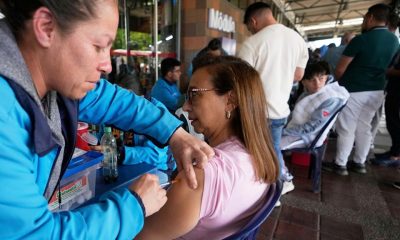International
Migrants, cheap labor to work in the fields in the south of Rome

Before dawn, Shoda, a 29-year-old Indian, goes out by bike to go to work in the countryside in Latina, an important agricultural province in the south of Rome and one of the most productive in Italy. It is one of the many migrants exploited as cheap labor in the area, the vast majority, according to the unions.
This young Indian from the Punjab region – like a large part of the migrants in Latina – travels every day the 20 kilometers between his rural neighborhood of the town of Aprilia and the green fields of Latina, where he collects seasonal fruit and vegetables since his arrival in Italy two years ago.
Shoda, one of the 30,000 members of the Indian community in the area, claims to be happy with his work, although he only charges about 6 euros an hour – below the about 10 that the agricultural agreement marks – but is outraged by the death last week of his compatriot Satnam Singh after a serious accident on a farm in the region.
After being run over by a machine that cut his arm, Singh was abandoned on the street next to his member amputated by his boss, who let him die from a hemorrhage that would have been contained if he had received the necessary medical attention.
“They treated him like an animal,” he denounces to EFE Shoda, who in recent days went out to protest a tragedy that has once again focused on the labor exploitation of migrants, very common in Latina, an area with about 30,000 agricultural workers, 70% of them foreigners and many irregular and without a contract.
Andrea Coinu, a member of the CGIL union, the largest in Italy, leaves these early morning days to talk to the migrants who leave at dawn to go to work.
In a van with a dozen more trade unionists, he walks through the fields and villages full of fruit trees and crops to inform them of their labor rights in the face of the “extended impunity” of agricultural owners and entrepreneurs that, he says, culminated in Singh’s tragic death last week.
Since that incident, in the area “there is a lot of tension and fear, both on the part of workers and entrepreneurs,” says Coinu, who distributes pamphlets and talks to Indian day laborers of the Sikh religion with the support of a translator shortly before they are picked up to go to the countryside.
Even in the early hours of the morning, other vans with more workers pass by. According to the CGIL, they go to work accompanied by foremen, one more sample of the ‘caporalato’, a system very widespread in Italian agriculture – it would affect 40% of employees in the center and south of the country – and that has been prevailing in Latina despite being vetoed by law for years.
It is based on employing cheap labor through foremen – part of them from the migrant community – who choose the workers and keep part of the money that the employer offers as a daily wage.
Faced with the controversy over the death of the Indian day laborer, a new victim of the ‘caporalato’, the far-right government of Giorgia Meloni insisted in recent days on its rejection of that system, while unions, part of the migrant community and the political opposition accused the Executive of inaction.
“There are people who only charge four euros an hour despite the strenuous work in the countryside,” says Coinu, who hopes that, after Singh’s tragedy, “the authorities will really invest time in changing things” in a sector “very based on exploitation.”
According to the complaint, the bosses of Latina profit from all this, an area of fascist tradition populated by settlers from northern Italy in a project launched by Benito Mussolini in the 1930s.
The area has many water resources, which makes Latina one of the large areas of kiwi production in Europe, as well as vineyards and crops of melons, tomatoes or cucumbers.
“It’s a tiring job, but it needs to be done to support the family,” another Indian migrant of about 50 years old who goes by bike to work and complains about the bad conditions.
As he explains, he changes crops and pattern according to the seasonal harvest, although unlike many others who must work clandestinely, he has a work permit and a stable situation.
That’s what three young Tunisians are looking for, hoping to improve their future in Italy, while the sunlight rises and they wait on the corner of a rural road for a vehicle to pick them up to go to work on a foreign land.
Central America
Senator Van Hollen Meets with Deported MS-13 Member in El Salvador; Trump and Bukele React

U.S. Democratic Senator Chris Van Hollen, representing the state of Maryland, held a meeting in El Salvador with deported MS-13 gang member Kilmar Ábrego García, a member of the criminal group classified by the U.S. government as a terrorist organization.
“Kilmar Ábrego García, miraculously resurrected from the ‘extermination camps’ and ‘torture chambers,’ now sipping margaritas with Senator Van Hollen in the tropical paradise of El Salvador!” wrote President Nayib Bukeleon X (formerly Twitter), sharing photos of Van Hollen, Ábrego García, and a lawyer sitting together at a Salvadoran hotel.
The deported gang member is seen wearing a plaid shirt and a flat-brimmed cap, seated at a table with glasses and coffee cups. The senator also shared images of the meeting on his own social media accounts.
Bukele reaffirmed that Ábrego will remain in El Salvador and will not be returned to the United States.
“Now that his health has been confirmed, he has earned the honor of remaining under the custody of El Salvador,” Bukele added.
Former U.S. President Donald Trump criticized the senator’s meeting with Ábrego on Truth Social, calling Van Hollen “a fool” for advocating for Ábrego’s return to the U.S.
International
Pope Francis Appears for Easter Blessing, Calls for Peace and Religious Freedom

Pope Francis, still recovering from pneumonia, appeared on the balcony of St. Peter’s Basilica in the Vatican on Easter Sunday and, with a faint voice, wished a “Happy Easter” to the thousands of faithful gathered to celebrate the Resurrection of Christ.
A month after being discharged from a lengthy hospital stay, the presence of the 88-year-old pontiff had remained uncertain, with the Vatican not confirming his attendance ahead of time.
Eventually, the pope made a brief appearance in a wheelchair shortly after 12:00 p.m. (10:00 GMT) to deliver his traditional “Urbi et Orbi” blessing (“to the city and to the world”).
Although no longer wearing an oxygen cannula, the Argentine Jesuit relied on a close aide to read his Easter message, which touched on major global conflicts.
Francis condemned the “dramatic and unworthy humanitarian crisis” in Gaza and called for a ceasefire, while also expressing concern over the “growing climate of antisemitism spreading across the globe.”
He further emphasized the importance of religious freedom and freedom of thought, stating that without mutual respect, “peace is not possible.”
International
Thousands rally nationwide against Trump’s threat to U.S. democracy

Thousands of protesters gathered on Saturday (April 19, 2025) in major cities like New York and Washington, as well as in small communities across the United States, in a second wave of demonstrations against President Donald Trump. The crowds denounced what they view as growing threats to the country’s democratic ideals.
In New York City, demonstrators of all ages rallied in front of the Public Library near Trump Tower, holding signs accusing the president of undermining democratic institutions and judicial independence.
Many protesters also criticized Trump’s hardline immigration policies, including mass deportations and raids targeting undocumented migrants.
“Democracy is in grave danger,” said Kathy Valyi, 73, the daughter of Holocaust survivors. She told AFP that the stories her parents shared about Adolf Hitler’s rise to power in 1930s Germany “are happening here now.”
In Washington, demonstrators voiced concern over what they see as Trump’s disregard for long-standing constitutional norms, such as the right to due process.
-

 International4 days ago
International4 days agoArsenal stun Real Madrid at the Bernabéu to reach Champions League semifinals
-

 Central America3 days ago
Central America3 days agoNicaraguan Exiles to Mark 7th Anniversary of 2018 Protests with Global Commemorations
-

 International3 days ago
International3 days agoDominican ‘False Hero’ Arrested for Faking Role in Nightclub Collapse That Killed 231
-

 International4 days ago
International4 days agoBogotá residents line up for yellow fever vaccine amid national alert
-

 International2 days ago
International2 days agoACLU seeks emergency court order to stop venezuelan deportations under Wartime Law
-

 International4 days ago
International4 days agoDeSantis’ immigration crackdown sparks alarm in Venezuelan Communities in Doral
-

 Central America2 days ago
Central America2 days agoUN complaint filed against Costa Rica over detention of migrant children
-

 International4 days ago
International4 days agoMexico refuses to restore ties with Ecuador while Noboa remains in office
-

 International18 hours ago
International18 hours agoThousands rally nationwide against Trump’s threat to U.S. democracy
-

 Central America18 mins ago
Central America18 mins agoSenator Van Hollen Meets with Deported MS-13 Member in El Salvador; Trump and Bukele React
-

 International19 mins ago
International19 mins agoPope Francis Appears for Easter Blessing, Calls for Peace and Religious Freedom















